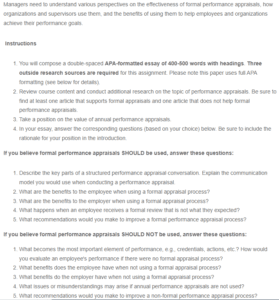The Value of Structured Performance Appraisals
Parts of a Structured Performance Appraisal
According to Skinner & Green (2010), one of the essential parts of a structured performance appraisal system is the equal application of standards. The appraiser must be above reproach whenever an employee is subjected to an appraisal process. An employee may not like being appraised by someone who has been consistently wrong. Also, the appraisal conversation must be a review exercise. It is counterproductive to accumulate the wrongdoings of an employee for an extended period only to surprise them during an appraisal exercise. Instead, the appraisal conversation should review what has been highlighted in the past.
Moreover, the appraisal exercise must allow for employee feedback. While reviewing an employee’s performance, the appraiser must enable them to comment on their performance and that of the organization. After all, an employee is affected by the organizational environment since they do not work in a vacuum. Face-to-face communication is the best. Face-communication model Face-to-face communication allows managers or appraisers to raise employee concerns directly (Kikoski, 1998). Also, employees have an opportunity to provide immediate feedback.
Do you want help with your assignment? Get in touch with us at eminencepapers.com.
Benefits to the Employee when Using a Formal Appraisal Process
One of the benefits accruing from formal employee appraisal exercises is that it leads to employee engagement. During the appraisal exercise, the employee can hear from the organization and offer feedback. Consequently, higher employee engagement leads to a productive workforce and encourages employees’ willingness to keep working for the organization (Picincu, 2019). Another benefit of formal employee appraisal is that it supports professional development. While appraising employees, managers identify areas that need training (Picincu, 2019). Some organizations are willing to even invest in their employee’s career development.
Benefits to the Employer when Using a Formal Appraisal Process
A key benefit of formal employee appraisal to the employer is improving organizational communication. The appraisal review allows managers to communicate openly with employees (Picincu, 2019). Henceforth, it will be easy for managers to share their expectations with employees. Appraisal also helps the organization retain top organizational talent. Through the appraisal exercise, employees express the problems they face in a company. Consequently, the employer can make adjustments to retain top talent.
When Employees Receive Unexpected Reviews
Employees have the right to dispute a performance review they disagree with. If a review is a surprise, the employee should take time to calm down so they do not respond angrily. Afterward, the employee should organize a meeting with their manager to discuss the review process details. The meeting should air out any disagreements and allow the employee to present an improvement plan.
Recommendations
Every appraisal exercise must be followed by an action plan to improve performance. Whether it is training, penalties, a promotion, or a raise in compensation, there should be a clear action plan to implement the outcome of an appraisal process. Notably, an organization should pay attention to its promises to its employees. If employees are promised a salary increment, the organization should follow through to ensure this commitment is implemented. An appraisal exercise is not over until employees and managers accomplish their responsibilities. Also, the appraisal reviews must not be a surprise or a witch-hunting mission. Instead, it should be a commitment to improving performance. That calls for managers to offer employees regular reviews on areas they need to improve. Subsequently, this will ensure there are no last-minute surprises during appraisal conversations.
References
Kikoski, J. (1998). Effective Communication in the Performance Appraisal Interview: Effective Communication in the Performance Appraisal Interview: Face-to-Face Communication for Public Managers in Face-to-Face Communication for Public Managers in the Culturally Diverse Workplace Culturally Diverse Workplace. https://digitalcommons.sacredheart.edu/cgi/viewcontent.cgi?article=1048&context=gov_fac&httpsredir=1&referer=
Picincu, A. (2019). What Are the Benefits of Performance Appraisals to the Organization? Chron.com. https://smallbusiness.chron.com/benefits-performance-appraisals-organization-15409.html
Skinner, J., & Green, R. (2010). Making the Grade: The Elements of an Effective Performance Appraisal – Library Worklife: Library Worklife. https://ala-apa.org/newsletter/2010/06/08/hr-practice/
ORDER A PLAGIARISM-FREE PAPER HERE
We’ll write everything from scratch
Question
Managers need to understand various perspectives on the effectiveness of formal performance appraisals, how organizations and supervisors use them, and the benefits of using them to help employees and organizations achieve their performance goals.

The Value of Structured Performance Appraisals
Instructions
- You will compose a double-spaced APA-formatted essay of 400-500 words with headings. Three outside research sources are required for this assignment. Please note this paper uses full APA formatting (see below for details).
- Review course content and conduct additional research on the topic of performance appraisals. Be sure to find at least one article that supports formal appraisals and one article that does not help formal performance appraisals.
- Take a position on the value of annual performance appraisals.
- In your essay, answer the corresponding questions (based on your choice) below. Be sure to include the rationale for your position in the introduction.
If you believe formal performance appraisals SHOULD be used, answer these questions:
- Describe the key parts of a structured performance appraisal conversation. Explain the communication model you would use when conducting a performance appraisal.
- What are the benefits to the employee when using a formal appraisal process?
- What are the benefits to the employer when using a formal appraisal process?
- What happens when an employee receives a formal review that is not what they expected?
- What recommendations would you make to improve a formal performance appraisal process?
If you believe formal performance appraisals SHOULD NOT be used, answer these questions:
- What becomes the most important element of performance, e.g., credentials, actions, etc.? How would you evaluate an employee’s performance if there were no formal appraisal process?
- What benefits does the employee have when not using a formal appraisal process?
- What benefits do the employer have when not using a formal appraisal process?
- What issues or misunderstandings may arise if annual performance appraisals are not used?
- What recommendations would you make to improve a non-formal performance appraisal process?

